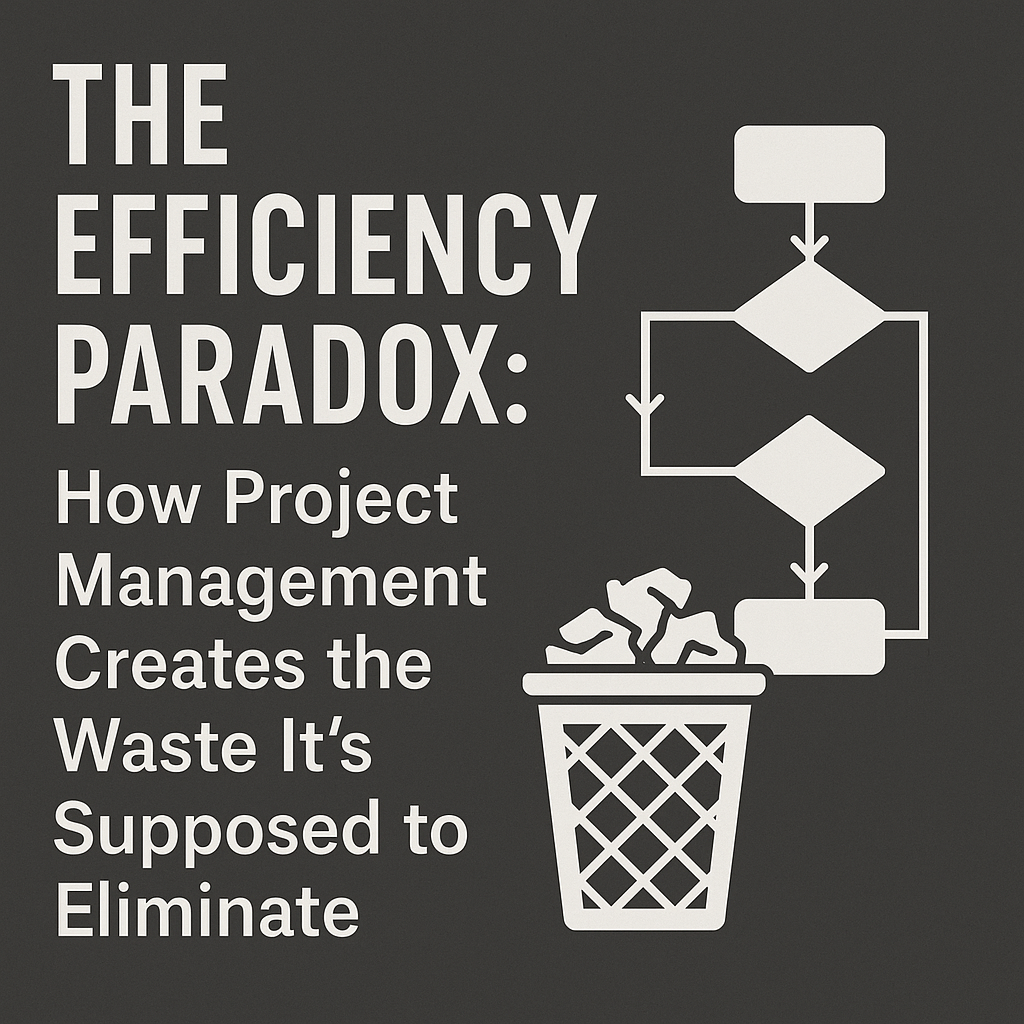Part 2: Leading Beyond Process

The Efficiency Paradox: How Project Management Creates the Waste It's Supposed to Eliminate
In Part 1, we exposed the fundamental flaw of traditional project management: its obsession with measuring process adherence instead of actual outcomes. Now let's examine the first devastating consequence of this misalignment, how these systems create the very inefficiencies they promise to prevent.
The promise of project management is seductive: implement our framework, follow our processes, use our tools, and watch inefficiency disappear. Delays will vanish. Waste will be eliminated. Resources will be optimized.
After 30 years watching organizations chase this promise, I can tell you what actually happens: these systems don't eliminate waste; they manufacture it at an industrial scale.
The Great Project Management Con
A colleague recently helped a growing software company calculate the true cost of their project management system. Not just licenses and training, but the full cost of compliance.
The number shocked them: $1.8 million annually.
This was a 200-person company. Nearly $2 million in pure overhead: time spent planning instead of doing, meeting instead of building, reporting instead of delivering.
The CEO's response? "But imagine how much we'd waste without these controls."
This is the great con of traditional project management. It doesn't prevent waste; it institutionalizes it, legitimizes it, and then makes you grateful for it.
1. Time Waste Disguised as "Best Practice"
The Meeting Industrial Complex
Look at how a "well-managed" project typically spends its time:
Monday: 2-hour sprint planning meeting
Tuesday: 1-hour architecture review, 30-minute standup, 1-hour dependency coordination
Wednesday: 30-minute standup, 2-hour stakeholder status update, 1-hour risk review
Thursday: 30-minute standup, 1-hour resource planning, 1-hour change control board
Friday: 30-minute standup, 1-hour retrospective, 2-hour steering committee prep
That's 14.5 hours of meetings to manage maybe 25.5 hours of actual work. Per person. Per week.
When you show this math to executives, the response is predictable: "But these are all necessary meetings. How else would we maintain alignment?"
They genuinely believe they'd accomplish less without these meetings. That somehow, those 25.5 hours of actual work would be less productive without 14.5 hours of talking about the work.
This is the efficiency paradox in its purest form: we're so busy maintaining alignment that we have no time to move forward.
The Planning Theater
Software teams routinely spend six weeks creating project plans. Hundreds of tasks. Thousands of dependencies. Resource allocations calculated to the half-day. Masterpieces of project planning.
By week three of execution, reality has made these plans worthless. Requirements change. Key people leave. Dependencies shift. Teams spend months in an endless cycle of re-planning, re-baselining, and explaining variances.
Here's what nobody admits: everyone knows the plan is fiction from day one. The developers know. The managers know. Even the executives know. But the planning theater continues because that's what the system demands.
We've created a cargo cult of planning: going through the motions of detailed scheduling while knowing it has no relationship to how work actually gets done.
2. Decision Paralysis Through Process
Death by Committee
Consider what happens when organizations need to select a simple component supplier. In the past, the lead engineer would have made the call in a week. Under "mature" project management frameworks:
Week 1-2: Prepare formal vendor evaluation matrix Week 3-4: Technical review board analysis Week 5-8: Waiting for monthly architecture board meeting Week 9-10: Security assessment committee review Week 11-16: Waiting for quarterly finance committee Week 17-18: Executive steering committee final approval
An 18-week process for a decision the lead engineer had right on day one. These delays cost companies first-mover advantage. Competitors using simpler decision processes often beat them to market by months.
PMOs call it "proper governance." The market calls it too late.
The Approval Trap
VPs of Engineering often find their calendars packed with:
- Dozens of "quick approval" meetings (15-30 minutes each)
- Multiple "decision review" sessions
- Various "sign-off ceremonies"
Actual time spent on strategic thinking, coaching teams, or solving hard problems? Often less than 10% of their week.
They aren't incompetent. They're trapped in systems that turn leaders into rubber stamps. Every decision that should happen at the team level floats up because the process demands "executive oversight."
The cruel irony? These approval meetings are pure theater. Leaders rarely have enough context to make informed decisions, so they rubber-stamp what teams recommend anyway. Everyone knows it. But the process demands its tribute.
3. Resource Waste Through Utilization Obsession
The 100% Utilization Myth
The project management orthodoxy preaches resource optimization. An idle resource is waste. The solution? Assign everyone to multiple projects. Keep them 100% utilized.
This flies in the face of decades of research. Alex Soojung-Kim Pang's book "Rest" documents how history's most productive people worked fewer hours, not more. Darwin worked four hours a day. Dickens wrote from 9 to 2. They understood what modern PM ignores: rest isn't the absence of work, it's a critical component of productivity.
Here's what happens to a typical senior developer under the 100% utilization model:
- Assigned to 5 concurrent projects
- Calendar shows 100% utilization (the PMO's definition of "optimal")
- Reality: 3 hours daily just remembering context
- 2 hours in project-specific meetings
- 1 hour updating five different tracking systems
- 2 hours actual coding
Their productivity is demonstrably lower than when working on two projects at 60% allocation. But utilization reports show green, so the system is "working."
The utilization obsession creates a special kind of waste: the illusion of productivity while destroying actual output. It's like running your car engine at redline while in neutral, then wondering why you're not moving forward.
The Tool Tax
Growing companies often invest surprising amounts in project management ecosystems:
- $50K to $200K in annual licenses
- Another $100K+ in integration costs
- At least one full-time administrator
- Days of mandatory training per employee
- 10-20% of project budgets for "tool compliance"
Companies with under 500 employees commonly spend over $3 million across five years on their PM systems.
Value delivered? Organizations rarely measure it. But they can show you beautiful dashboards.
The real cost isn't even the money. It's what happens to teams. Developers become data entry clerks. Architects become report generators. Project managers become tool administrators. Everyone feeds the beast while actual delivery suffers.
When someone suggests that better results might come from simpler approaches (a whiteboard and weekly conversations) the response is predictable: "But how would we track everything?"
That's when you know they're truly lost. They've forgotten that the goal isn't to track work, it's to deliver value.
The Hidden Costs Mount
The efficiency paradox creates costs that never appear in project reports:
Opportunity Cost: While established companies spend 18 months planning cloud strategies, nimble competitors launch multiple services. While traditional firms perfect their processes, startups disrupt entire industries. The greatest waste isn't what we spend. It's what we miss while we're busy managing.
Talent Drain: Your best people joined to solve hard problems and build amazing things. When you turn them into process administrators, they have three options:
- Disengage and collect a paycheck
- Leave for somewhere that values their talents
- Subvert your system to get real work done
All three happen regularly. For a mid-sized company, the cost of replacing a senior engineer typically exceeds $150,000. The cost of keeping one who's disengaged? Immeasurable.
Innovation Suffocation: 3M created Post-It Notes because they gave researchers 15% time to explore. Google created Gmail during "20% time." Traditional project management eliminates this slack in the name of efficiency.
Zero slack means zero innovation. We optimize ourselves out of breakthroughs.
The Efficiency Illusion
The most insidious aspect of traditional project management is how it creates the illusion of control while masking reality.
Organizations celebrate their "mature" project management processes while their actual delivery metrics tell a different story: projects routinely running 50% over timeline, teams burning out from process overhead, and customers complaining about slow delivery.
But the reports look professional. The processes are documented. The methodology is certified. Everyone's busy. Meetings are scheduled. Updates are flowing.
We mistake activity for progress, process compliance for performance.
As one director put it: "We have beautiful processes that produce mediocre results, but nobody questions it because we're following 'best practices.'"
This is the efficiency illusion: confusing the appearance of good management with actual value delivery. We've created elaborate systems that make us feel in control while the real work struggles to get done around the edges of all our process.
The Leader's Dilemma
Leaders in this environment face an impossible choice:
Option 1: Comply and Pretend Play along with efficiency theater. Projects will look perfect on paper. The PMO will be happy. Dashboards will glow green. And teams will deliver late, over budget, with burned-out people. But hey, the process was followed.
Option 2: Fight and Fail Buck the system. Skip the useless meetings. Make decisions without committee approval. Focus on delivery over documentation. Get labeled a "cowboy," a "loose cannon," someone who "doesn't understand governance." Even successful delivery gets punished for not following process.
Most talented leaders choose Option 1. It's safer. It's what's rewarded. And when projects fail, they can always blame "poor execution" rather than questioning the system itself.
But there's a third option, one that requires courage to implement and wisdom to navigate.
The Path Forward
The solution isn't to abandon all structure. Chaos isn't the answer to bad process. The solution is to recognize a fundamental truth:
Efficiency isn't about utilizing every minute or following every process. It's about creating value with minimum waste.
This requires:
- Pushing decisions down to the people with the most context
- Creating slack for innovation and response
- Measuring value delivered, not activities performed
- Trusting teams over tools
- Simplifying systems instead of adding controls
Organizations that embrace these principles see dramatic improvements. Companies have cut project overhead by 60% through simple changes:
- Replacing status meetings with brief daily standups
- Giving teams real spending authority without layers of approval
- Measuring value delivered to customers instead of process compliance
Their project success rates can improve from under 40% to over 75% in a single year.
The Deeper Damage
But here's the thing: the inefficiencies we've explored are just the visible part of the iceberg. The deeper damage happens below the surface.
Traditional project management doesn't just waste time and money. It destroys the very things that make organizations capable of excellence: quality work, seized opportunities, and most critically, engaged humans who care about outcomes.
In the next part of this series, we'll explore how these systems guarantee mediocre results by design. Because when you optimize for process compliance over value delivery, mediocrity isn't a bug. It's a feature.
The project management industrial complex has sold us efficiency and delivered waste. But that's not even their biggest con. Their biggest con is making us believe that this is the best we can do.
It's not. And it's time we proved it.
Next: Part 3 - "The Effectiveness Trap: How Traditional PM Guarantees Mediocre Results"




